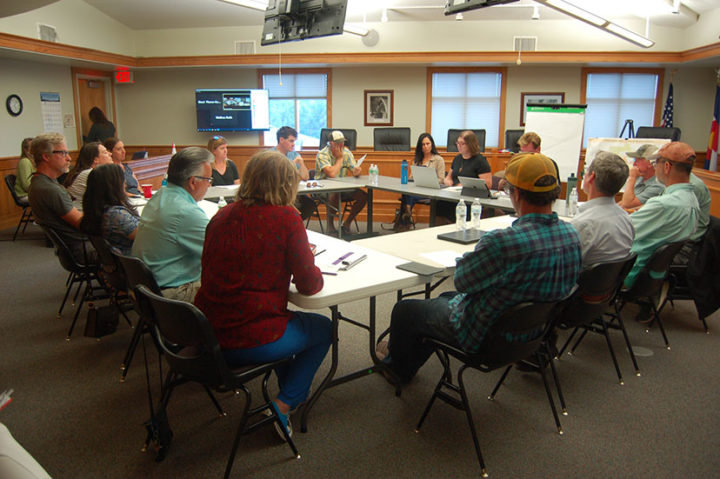Here we are listening to Jennifer Gardner, a consultant with LoganSimpson, essentially asking a table full of volunteers to consider the addition of ‘inclusionary housing’ to the Town’s Land Use and Development Code. The groups seated at the table on July 29 were the Town Council, the Town Planning Commission, and the Pagosa Springs Area Tourism Board.
“Some of you may have been talking about ‘inclusionary zoning’ at the recent Town Council retreat. Inclusionary zoning is a tool that requires new development to include affordable units. That’s kind of a simplified version of it. Normally, it means, if you have, say, ten units in a normal apartment building or multi-family dwelling, it might require you to have two units to be affordable, and the other eight to be market rate. There are different thresholds that you can develop, but that’s basically the baseline for inclusionary zoning.
“It’s a mandatory requirement to add affordability to multi-unit housing projects…”
A few problems with what Ms. Gardner was saying.
First of all, inclusionary zoning was never discussed at the recent Council retreat, as far as I recall. Certainly, it was not discussed in any serious way.
Secondly, although dozens of communities have inserted inclusionary zoning into their land use codes, many of the programs are not ‘mandatory’; they apply only when the developer is seeking a variance or other special treatment.
The next problem is that Ms. Gardner is talking to a roomful of well-meaning volunteers, most of whom have, practically speaking, zero background knowledge about whether inclusionary zoning would work successfully in Pagosa Springs, or if it would be an unmitigated disaster.
Next, we have the problem that inclusionary zoning sometimes functions to reduce the number of affordable housing units, while driving up the cost of housing for middle income families.
And finally, we have the problem that even so-called housing experts — perhaps even our own local leaders? — don’t understand the pros and cons of inclusionary housing. Because it seems simple… but it’s actually terribly complicated… and poorly understood…
We can listen, for example, to George Galster, a professor of Urban Studies at Wayne State University, assuring the Portland (Oregon) City Council, in 2016, that inclusionary zoning is a well-established practice, used all around the country for the past 40 years:
…they are in operation in hundreds of cities and counties across the United States, including fast-growing Portland-sized places like Denver and Minneapolis.
That statement is mostly true: lots of places have adopted something they call ‘inclusionary zoning’ or ‘inclusionary housing.’… but the name gets applied to a wide range of programs, most of them insignificant, or ineffective. Or worse.
From an op-ed by Joe Cortwright, on CityObservatory.org, 2018:
As we’ve reported at City Observatory, there’s less to most inclusionary zoning programs than meets the eye: While impressive sounding on paper (and perhaps in the press) they tend to produce very few units of new housing, typically due to the limited scope and discretionary application.
And in the case of Denver and Minneapolis, the two instances specifically cited by Dr. Galster, there’s even less that meets the eye…
Minneapolis did not, in fact, have an inclusionary housing program in 2016, in spite of Dr. Galster’s claim. (It has since put one in place.) What Minneapolis had was a density bonus program.
And Denver had already voted to repeal its inclusionary housing program. Section 27-105(a) of the city’s development code had required some new developments of 20 or more units to set aside 10 percent of newly-added units for households earning less than 80 percent of the area’s median income. The requirement was repealed effective January 1, 2017. The Denver program produced a paltry 77 units since it was established in 2002. An average of five units per year… in a city of 290,000 homes?
In place of inclusionary housing, Denver has now adopted a new Permanent Housing Trust Fund, which will provide an estimated $15 million per year for the next decade to help acquire and rehabilitate low- and moderate-income housing. We can imagine this will result in more than five homes per year.
The Portland City Council apparently listened to Professor Galster, however, and created new inclusionary zoning rules for their city in 2016. In an op-ed in the Oregonian, Gerard Mildner, an associate professor of real estate finance at Portland State University, called attention to the impacts.
“The city’s housing policy is in shambles. Housing production in the city has collapsed in recent years, despite record home prices and rents. Portland remains attractive to migrants from California, yet our excessive regulation of new development has caused existing housing to become ever more unaffordable…”
Portland’s new mandate did not apply to projects already in the pipeline, so — according to Professor Mildner — it took three years for the full effects of inclusionary zoning to be felt. Since the full-scale imposition of the mandate, “housing permits in the city fell from 5,094 housing units in 2019 to 1,779 units in 2020, a decline of 65%.”
Unfortunately, many ‘planning’ schemes, while aiming at improving a town, are undertaken not because they’ve been proven effective, but merely because “Denver and Minneapolis are doing it, so it must be a great thing.”
Even if it’s not.


